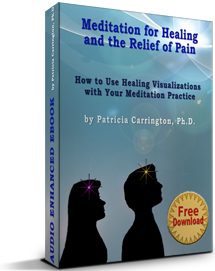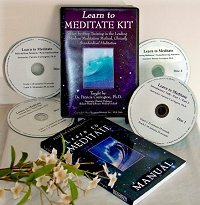Dr. Patricia Carrington's award winning meditation technique CSM (Clinically Standardized Meditation) is a clinically sensitive meditation method developed by the Medical Department of New York Telephone Company and used by numerous medical institutions, organizations, and individuals worldwide. For information click here.
Managing Tension-Release during Meditation
Techniques for Handling Persistent Side-Effects
Patricia Carrington, Ph.D.
Author of “The Book of Meditation”
Very occasionally, side-effects from tension-release refuse to go away, but persist after the session. If this happens there are some effective techniques for dealing with it.
The first deals with physical side-effects. Let us say that stress release takes the form of a physical symptom, perhaps a localized pain in the back of the head. If it is a pain that first appeared during meditation (an indication that it is probably due to tension-release) and refuses to leave by the end of the session, one strategy is to stop whatever meditative focus you ordinarily concentrate upon and turn your attention lightly onto the area of pain itself, absorbing yourself entirely in it. You are not trying to get rid of the pain or fighting against it in any way, but simply using it as a meditational focus, as you might use a mantra.
This way you will come to know the pain minutely and sensitively. You will ‘fuse’ with it, rather than opposing it as though it were an outside force, and by doing so will change the situation. As you come more into harmony with the pain, it may spontaneously dissolve without any effort on your part. Strange as it may seem, I have yet to see this device fail, and I recommend it for any persistent physical side-effect of meditation.
Emotional side-effects, such as uncontrollable crying, which continue after the session, may need to be handled differently. Usually such release phenomena have their own timetable. A ‘crying jag’, for example, may be beneficial if allowed to play itself out and will usually self-terminate.
If anxiety which is stirred up during meditation continues afterward, an effective tactic is to take a few long, slow breaths, letting the air flow downward deeply into your lungs until it feels as though it has reached and permeated your entire abdomen. After this, very slowly exhale your breath until the last of the air seeps out. If you wish, you can even imagine that the air is flowing downward throughout your whole body as you breathe in, and that it is flowing out through the soles of your feet as you breathe out.
Deep-breathing exercises such as these, perhaps coupled with some simple physical exercises such as Yoga stretches, are usually effective in handling an upsurge of anxiety. It is also useful to talk over any uncomfortable thoughts or feelings which may have surfaced during meditation with a person you trust. The experience of sharing these discomforting sensations with another can sometimes lead to important insights and considerable relief.
If none of these tactics is effective, then you need a temporary rest from meditating and should suspend meditation for five days. This is an excellent strategy for helping stress-release to right itself. When this interval is up, return to meditating, slowly at first, perhaps starting with only five or ten minutes once a day and only gradually increasing meditation time as it feels comfortable to do so. Feel free to back off and shorten your meditation time again if necessary, or even to take another rest from it. Your own flexibility and good judgment should be the yardstick.

